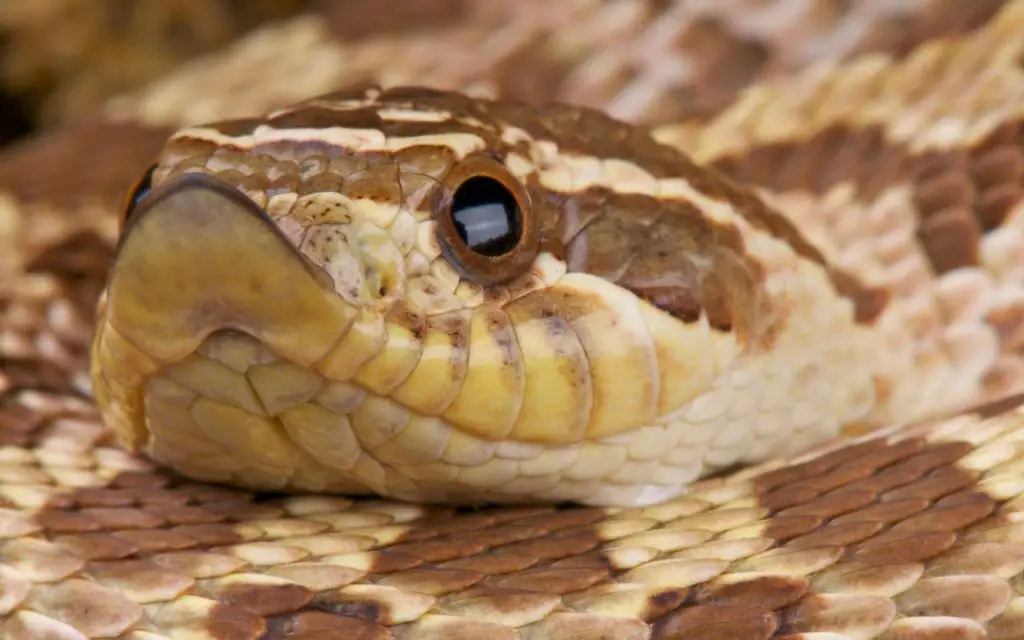This snake is one of the most popular pet reptiles in the world. Come and read our Western Hognose Snake Care Sheet to find out why!
Last updated on February 1st, 2023 at 09:35 am
The Western Hognose Snake (Heterodon nasicus), also known as the Plains Hognose, is an almost goofy-looking snake found in plains and scrub ecosystems. Thanks to their small size, and tendency to do well on a simple rodent diet, their captive care is extremely easy – just remember to keep their humidity quite low.
Western Hognose Snake tank size
We’re going to discuss humidity, lifespan, and everything else you need to know shortly. But first, lets discuss tank size so that you know what kind of investment you’re looking at!
Given that this is a small, often semi-fossorial species, they can be kept in quite small enclosures. In fact, a lot of people notice that if they house them in enclosures that are too large, they suffer from anxiety and go on hunger strike.
Most adult Western Hoggies will be perfectly happy in a vivarium, tank or tub that is 24 inches (60cm) long by 10 inches (25cm) tall and 12 inches (30cm) deep. Occasionally, some very large females will need a larger setup of 36 inches (90cm) long by 12 inches (25cm) tall and 18 inches (30cm) deep.
Hatchlings, on the other hand, need much smaller enclosures. Instead, provide them with a small tub or faunarium that is only 10 to 12 inches long.
Personally, I think the best way to house baby Hognose Snakes is by keeping them in plastic tubs, and gradually increasing the size of the tubs until they are fully grown and ready for their adult enclosure.
When it comes to adult enclosure type, people often get a little too caught up on this question. You can use a plastic tub, vivarium, PVC enclosure, or glass tank.
It actually doesn’t matter as long as it provides adequate ventilation, or you can adapt it so that it does. These snakes don’t do well with high humidity!
For plastic tubs, you can buy mesh screen inserts and patches online to increase ventilation through their lids. After doing this, you will still find that these enclosures are cheaper, and easier to customize than vivariums.
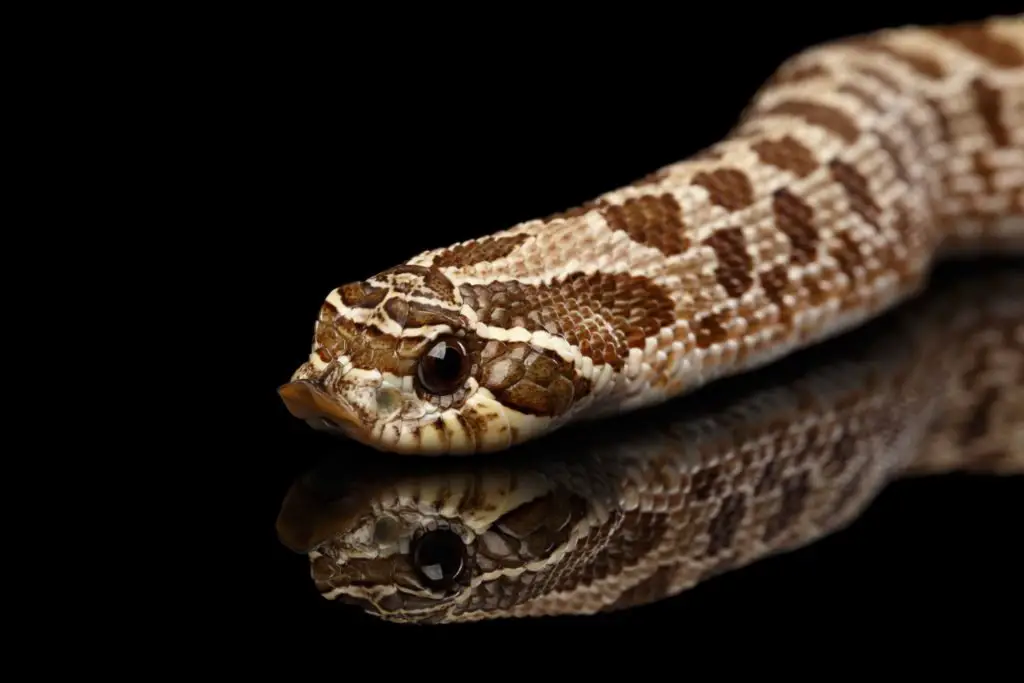
Can I keep two hognose snakes together?
You should not keep Hognose Snakes together, whatever species you keep. Some of the females get ravenous when preparing to breed, and occasionally decide that a male looks like a tasty snack.
In fact, the week of writing this care sheet I was told by a breeder about this happening to one of their acquaintances. It seems cannibalism is a real risk with these snakes.
Just like my anti-social Ball Pythons, Hognoses are perfectly happy on their own – they don’t get lonely.
If you would like to keep snakes together, then instead opt for Rough Green Snakes, Water Snakes (Nerodia sp.) or Garters.
Enclosure and supplies checklist – what you’ll need
Before we go any further, let’s go through a checklist of supplies that you’ll need so you can start planning. When it comes to heating appliances and thermostats, we’ll go into more detail about how to choose these in the Temperature section.
For a hatchling, or adult in a plastic tub, you’ll need:
- Appropriately sized plastic tub
- Something to make ventilation holes, or ventilation inserts
- Substrate (aspen)
- Heat mat that covers roughly one third of the underside of the enclosure
- On/off or pulse-proportional thermostat
- Digital thermometer
- Humidity gauge
- Water bowl
- Hiding places
For an adult in a vivarium set up, you’ll need:
- A 24 inch (60cm) long vivarium
- Substrate (aspen)
- A 100 watt Heat lamp or watt ceramic heat emitter
- Heat lamp/emitter guard to prevent burns
- Dimming or pulse-proportional thermostat
- Digital thermometer
- Humidity gauge
- Water bowl
- Hiding places
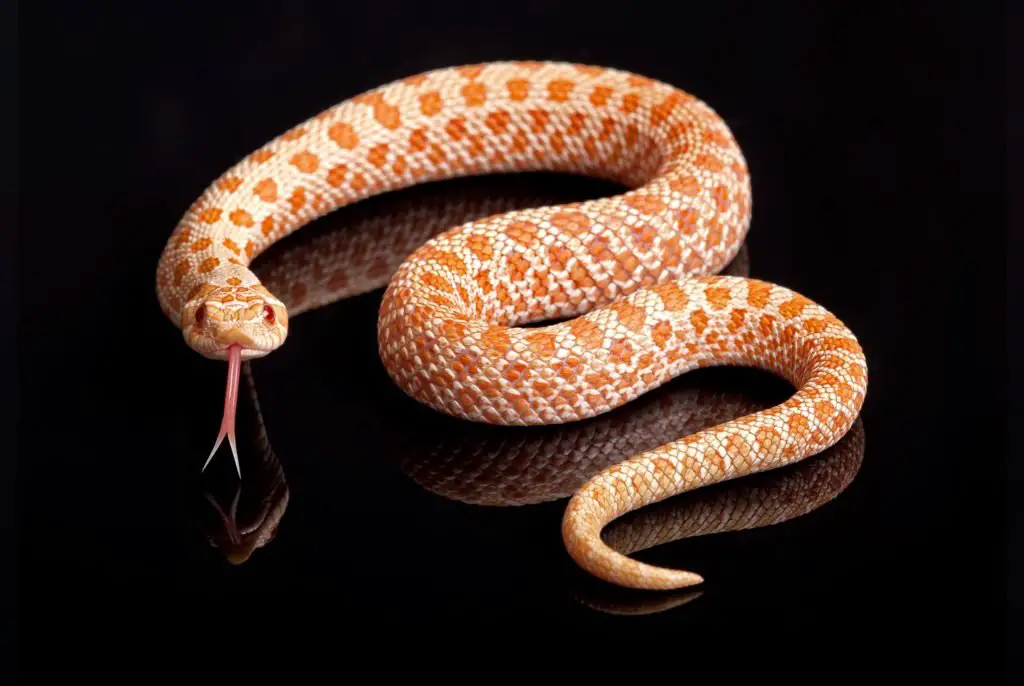
How big do Western Hognose Snakes get?
One of the main factors that makes Western Hognose snakes easy to deal with is their size. Like the Tricolor Hognose, these snakes rarely get over two feet long. When fully grown, you can expect males to reach roughly 16 inches (40cm) and females between 22 and 24inches (55 and 60cm).
Very occasionally you may see females up to 30 inches (76cm) long. The official record to date for the largest Western Hognose is 35 inches (89cm).
For their part, hatchlings are tiny, and start out at 6 or 7 inches (15 to 18cm) long. Nonetheless, they are still a lot chunkier than other colubrid hatchlings of a similar length. If they eat well (which most of them do), hatchlings will be fully grown after roughly two years.
| Age/sex: | Size: |
| Hatchling | 6 or 7 inches (15 to 18cm) |
| Adult males | 16 inches (40cm) |
| Adult females: | 22 and 24inches (55 and 60cm), occasionally 30 inches (76cm) |
| Record: | 35 inches (89cm) |
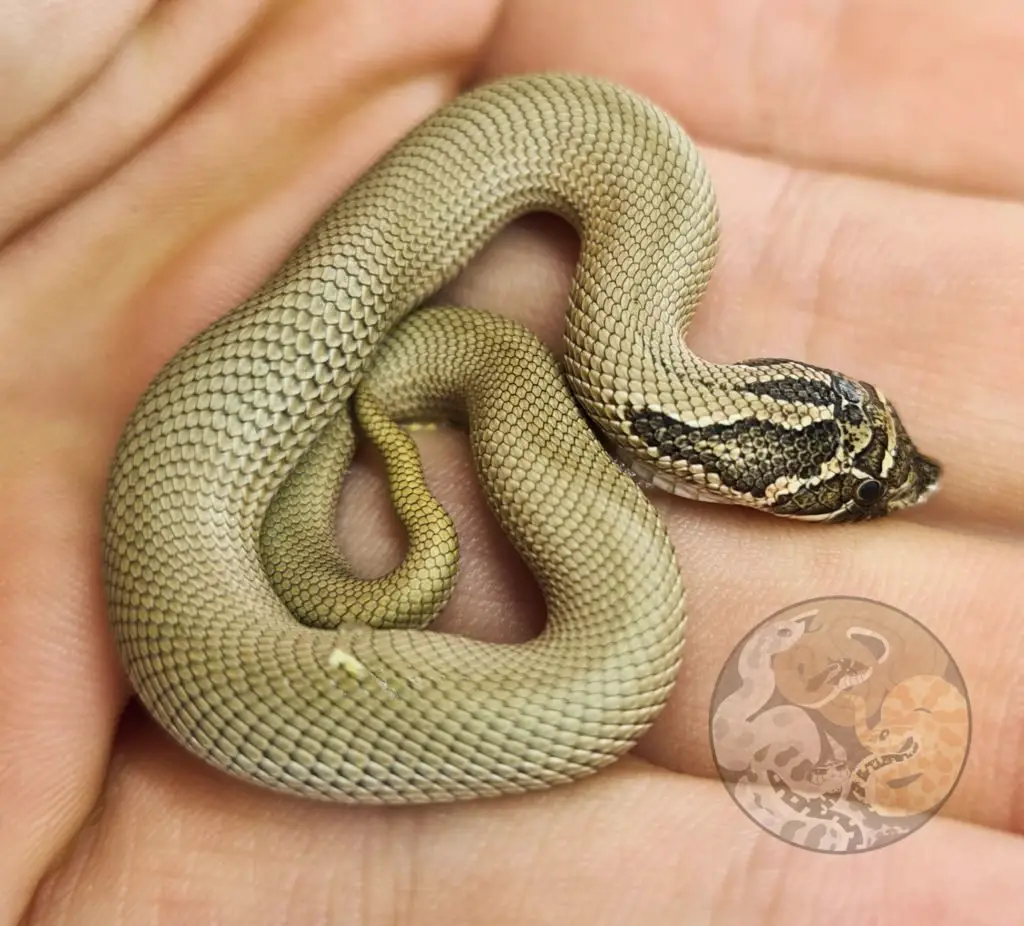
Are Western Hognose snakes good for beginners?
Western Hognose Snakes are one of the best snakes for beginners. They are small, hardy, and reluctant to bite. They are also widely available and extremely popular. This point is important because it means that you can easily contact other keepers for help and advice. It also means that you can potentially breed them for a hobby.
Western Hognose Humidity and shedding
A huge proportion of this snake’s range is made up of dry scrub and sandy or gravelly habitat, west of the Mississippi river. In fact, it only has a few isolated populations east of the Mississippi where humidity is much higher.
This is the main thing your Hognose will need you to get right: moderate humidity. They do best at a humidity level of roughly 40%. If you keep them too damp, they will eventually get a disease like scale rot (necrotizing dermatitis) or a respiratory infection.
To keep their humidity at this level is quite easy in most houses. All you need to do is provide a substrate that isn’t dense enough to hold moisture, and adequate ventilation.
During shedding, you can provide a humid hide full of SLIGHTLY damp sphagnum moss to help the process, though many keepers say their Hogs’ shed fine without this.
Water
Always provide these snakes with a small but sturdy water bowl. You want one that is heavy for its size so it can’t be easily flipped over, but not big enough to increase humidity too much. This could mean a 4 inch (10cm) wide ceramic bowl, for example.

Western Hognose Snake Lifespan
Hoggies are tough – and though they don’t reach the insanely long lifespans of Boa Constrictors or good-old Python regius, they can live for up to 20 years in captivity. All in all, you can expect your snake to live for at least 12-15 years. Just provide them with consistent care and husbandry.
Substrate
There is a lot of conflicting advice on which substrate to use for Western Hognoses. Some people say coco coir or soil and sand mix, while others provide coco chips. From speaking to long-term breeders, however, the best overall substrate is aspen bedding.
Aspen bedding is a loose, dry bedding. Because it is made up of reasonable large, but light pieces, it doesn’t become as dense as coco coir or soil for example. This means aspen maintains a low humidity and is always easy for your Hognose to burrow through.
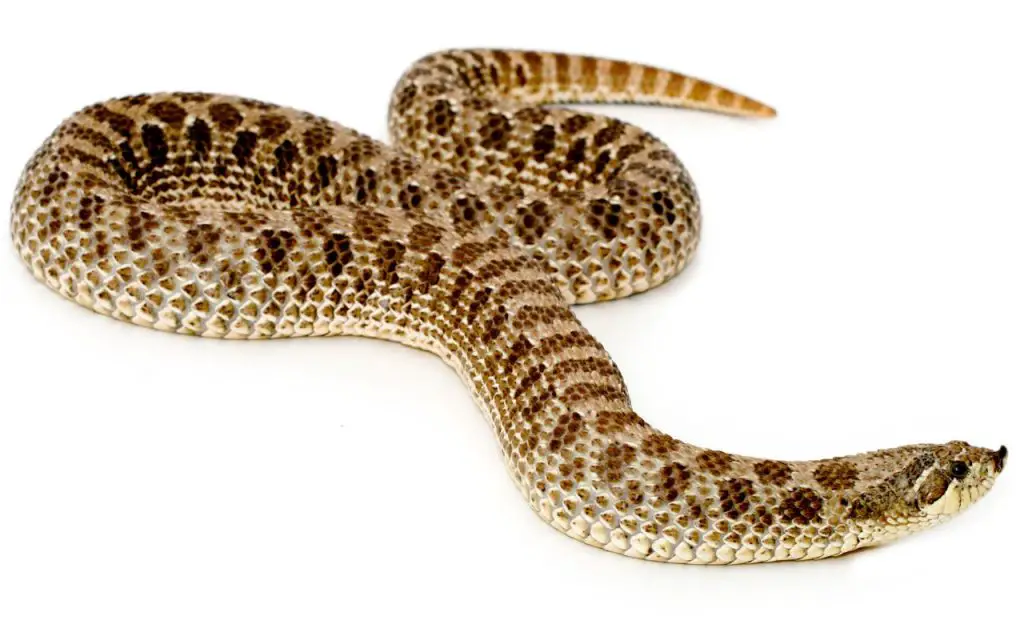
Are Hognose Snakes venomous?
Hognose Snakes are indeed venomous – though they aren’t particularly dangerous to anything larger than a mouse. Like many other snakes in their subfamily, the Dipsadinae, Western Hognoses have enlarged, grooved teeth at the back of their maxillae (upper jaws). Therefore, they are commonly referred to as “rear-fanged”.
These tiny teeth deliver a weak venom that the snakes chew into their prey to help paralyse them. Unfortunately – as with many other weakly venomous species – some people love to exaggerate how dangerous they could be.
Let’s not forget that the Mangrove Snake was commonly referred to as “potentially dangerous” back in the 90’s, before lots of hobbyists started keeping them and reported very mild bites…
In truth, Western Hognoses are not dangerous. Their bite does occasionally cause numbness, pain and swelling, but won’t do lasting harm to most people. Notice how I say most people, though. As always, every individual reacts differently to bites.
*Always take any bite seriously. Though a snake may not be truly dangerous, an allergic reaction is always possible. This is just the same as bug bites and bee stings.
Do Hognose Snakes bite?
In general, this species does not bite. Nonetheless, they do get grouchy, sometimes even puffing and hissing when you pick them up. This is a complete bluff, however, and once you get to know them it’s more amusing than intimidating.
If you did get bitten, it would probably be the result of a feeding accident, which is completely avoidable by using forceps or tongs to feed.
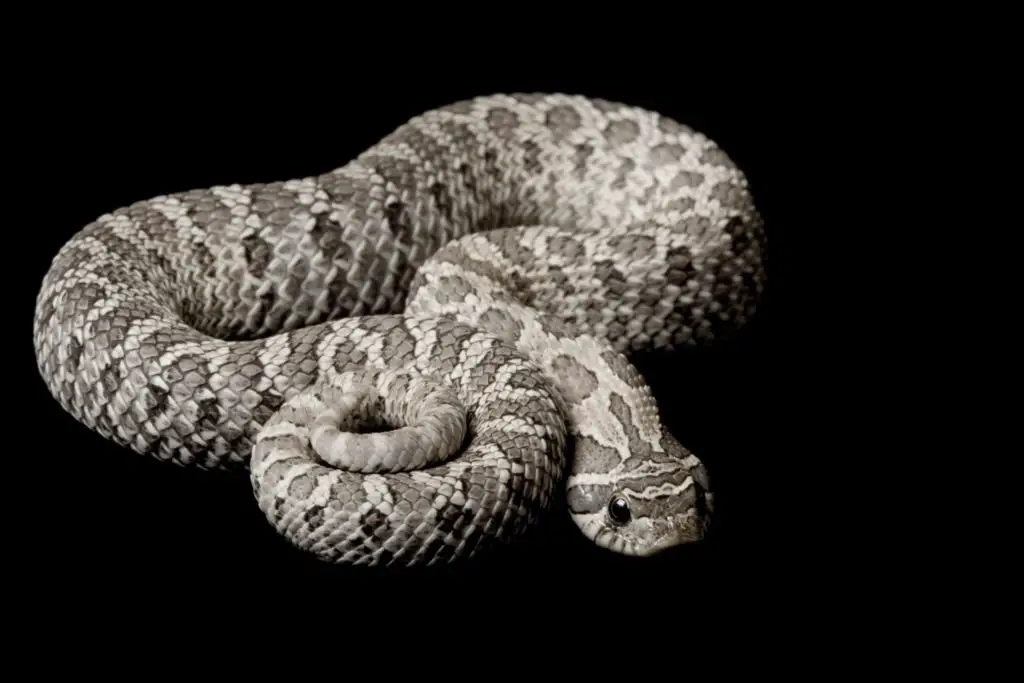
What do Western Hognose Snakes eat?
In the wild Western Hoggies eat a variety of prey at different times of the year. They have been observed feeding on snakes, lizards, reptile eggs, birds, frogs, toads, and small rodents. In some areas, studies have even found that they shift feeding preferences according to their age or the season.
Some have been found to prey on lizards when young, before switching to turtle eggs and toads when close to adulthood! Others have been observed moving into wetlands to feed on frogs during the height of summer. This may explain why some male Hognoses go on hunger strike during the summer.
In captivity, it’s best to provide your snake with a diet of frozen mice. These are a nutritionally complete food source when reared on a good diet. They are also much less likely to carry parasites than amphibians and lizards due to the freezing process.
How often do you feed a Western Hognose?
Baby Hognoses up to six months of age should be fed every 5 days. Give them a meal as thick as their greatest girth and increase it as they grow.
Adults should be fed one large mouse every week, except for larger females which will happily eat two if preparing to breed.
As with other species, avoid handling them for a day after eating to minimise the risk of regurgitation. Also, be aware that they can be clumsy strikers: always use tongs to feed them!

Temperature
Western Hognose Snakes experience high ground temperatures in the wild, to the point that they will even hide below the surface during the midday heat.
In captivity, most keepers notice that they are most comfortable when given a warm spot of 90f (32c). At the opposite end of the enclosure, the temperature can be lower, around 75 to 80f (24 to 27c). With temperatures like these, you snake has a thermal gradient that allows it to choose what temperature it wants to be.
The warm spot can stay the same at night, but the cool end should drop by a few degrees, to a minimum of 70f (21c).
Always make sure that hiding places and deep enough substrate for your snake to burrow in are available at both ends of the enclosure.
Heating appliances
For plastic tubs, heat mats are by far the best (and safest) heating appliance, though heat cables can also work. For vivariums, it is easiest to use a heat lamp or ceramic heat emitter.
Given that these snakes live in small enclosures, you may not have the room to use a heat lamp for daytime heat and ceramic heat emitter for night-time heat. This would be more appropriate for enclosures that are 36 inches (90cm) long or larger.
If you want to use a heat lamp as the sole source of heat, then use one that emits blue or red light. These will minimise the disruption to your snake’s sleep. Alternatively, just use a ceramic heat emitter.
Please remember that you must mount a heat lamp or heat emitter to the roof of the enclosure inside a guard. The guards are made of metal and will prevent your pet from burning itself.

Which thermostat to use
| Heating appliance: | Thermostat needed: |
| Heat mat | On/off or pulse-proportional |
| Heat lamp | Dimming |
| Ceramic heat emitter | Pulse-proportional |
| Heat cable | On/off or pulse-proportional |
| Reptile radiators, deep heat projectors, high-power heat mats | Pulse-proportional |
Handling
Most Hognose snakes are incredibly relaxed and docile once you have picked them up and removed them from their tub. I recommend handling them for 5 minutes or so, twice a week to keep them nicely habituated to interaction. As with most other snake species, repeated, gentle handling is the key to taming them.
When shedding it’s best to avoid handling except for cleaning the tub if needed. At this time, they can be easily stressed and extra grouchy. Generally, their body language will change if this is the case, exhibiting a lot more puffing and perhaps some head-butting.
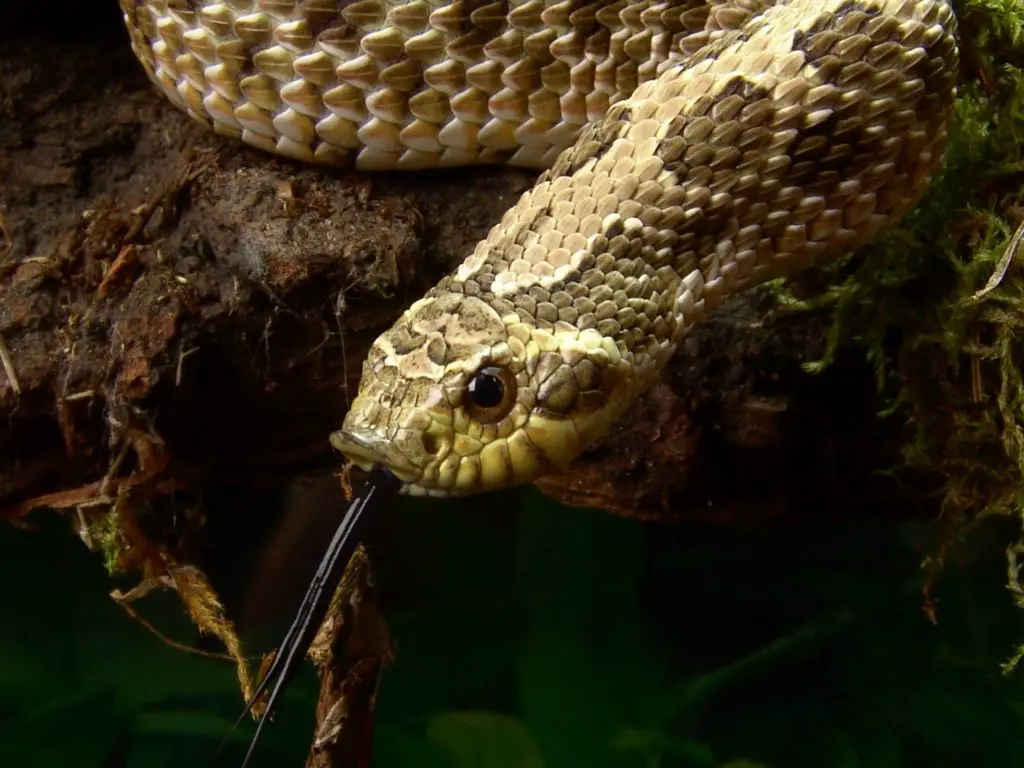
Lighting
Western Hognose Snakes are mostly diurnal, being active in the early morning and late afternoon. This means that will need some form of light so that they can tell the time. After all, this is how they regulate their circadian rhythm. This light can be from your window, the light in the room, an LED lighting strip, or a UV bulb.
If you do not want your Hognose to brumate (hibernate), or breed, then keep its lighting on a constant 12-hour cycle, year-round. Otherwise, you may notice that it stops eating during winter.
Do Western hognose snakes need UVB?
Interestingly, Hognose Snakes seem to do completely fine without UVB or UVA light, so long as they have some light of some description. Though they are regularly encountered in the open in the wild, they do seem to be able to extract Vitamin D from their prey and live long, healthy lives without UV lighting.
In my opinion, they do not need UVB, but only if you’re feeding them healthy rodents, raised on a balanced diet. Make sure you source them from a reputable supplier who is willing to answer your questions!
Morphs
There are some incredible Western Hognose Snake morphs available now. From the classic Albino to newer recessive genes like Pistachio and Leucistic. When it comes to incomplete dominant and dominant morphs my favourite must be the Anaconda, which has a nice reduced, spotty pattern.
Many of these morphs start out at a high price but come down quite fast – so it’s worth checking them all out before buying your new pet.

Western Hognose Snake for sale
This species is now firmly established in captivity. There is no reason to buy a wild-caught Hognose and you should decline if offered. Fortunately, almost all the Western Hognoses you see for sale online are captive bred. To find one, it’s best to talk directly to a breeder, rather than going to a pet shop.
When buying one of these snakes, make sure that it has been feeding consistently for at least four weeks. Most breeders will be happy to even send you a photo of a snake feeding. If this isn’t forthcoming – look elsewhere!
As always, look for breeders on websites where you can read feedback and reviews to help keep yourself safe.
Western Hognose Snake Facts and Care Summary Table
| Common names: | – Western Hognose – Plains Hognose – Blow Viper – Spreading adder |
| Scientific name: | Heterodon nasicus |
| Distribution: | Central plains region, from southern Canada to Texas |
| Activity rythm: | Diurnal |
| Habits: | Semi-fossorial when suits |
| Habitat: | Grasslands, dry scrub, gravelly soils |
| Temperature: | Warm end 90f (32c), cool end 75 to 80f (24 to 27c) |
| Humidity: | 40% |
| Favourite food: | Mice (in captivity) |
| Enclosure size: | – 24 inches (60cm) x 10 inches (25cm) x 12 inches (30cm) for most adults – 36 inches (90cm) long by 12 inches (25cm) tall and 18 inches (30cm) deep for very large females |
| Lighting needs: | UV beneficial but not essential |

Key points to remember about Hognose Snake Care:
- Western Hognose snakes occupy a huge range in western North America, from Minnesota all the way down to northern Mexico. Accross this distribution they always prefer drier areas of habitat: do not let them get too humid, otherwise health issues like respiratory infections can set in.
- These small snakes do well without a UVB bulb – but they do need light of some description, if only to tell them when it’s day time or night time. It can be an LED strip in the enclosure, light from a window (just don’t put the enclosure next to it), or a light in the room: it really doesn’t matter. In many cases, pushing UVB lighting is simply a way for websites to make more money from affiliate links.
- Your pet hognose snake does have mild venom, no matter how cute it looks. Generally speaking, these snakes are incredibly reluctant to bite, and the only chance of this happening is at feeding time. Accidental bites are generally about as severe as a bee sting, but you should always take a bite from any animal seriously and be aware of the possibility for an allergic reaction (though it’s incredibly rare).
- Some websites are now claiming that these snakes don’t need heat at night, before going on to tell you how bad they think heat mats are. This seems to stem from the idea that they are diurnal snakes and should get their warmth from a heat lamp, which can be left off at night. In truth, it doesn’t matter where heat comes from, so long as you measure it correctly, but reptiles should be able to thermoregulate at any time – day or night. Like most reptiles, breeders have noticed that hognose snakes do best when do have a warm spot both during the day and night, and this can be achieved with either a heat pad, heat tape or a ceramic heat emitter – none of which prevent you from using a heat lamp during the day if you wish.
- Western Hognoses do not need a large enclosure, but aren’t well suited to a typical rack system. Racks can be made to work for them, but a ventilation panel must be fitted to the front of each tub to let in air and light.
- The best substrate overall is aspen chips. This type of bedding lets Hognose snakes burrow and keeps humidity down.

